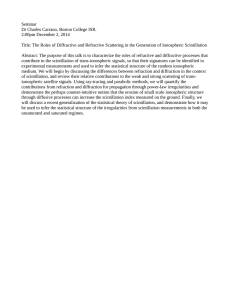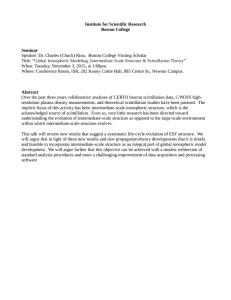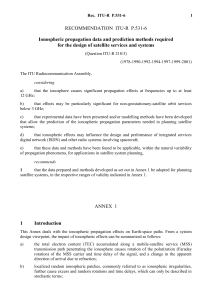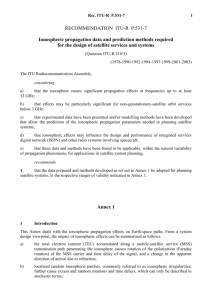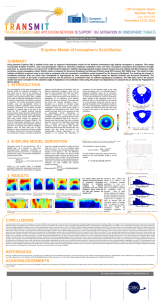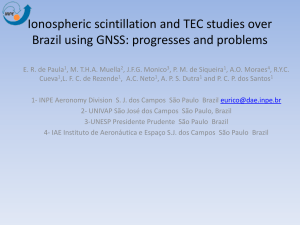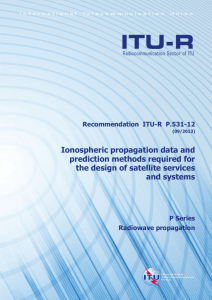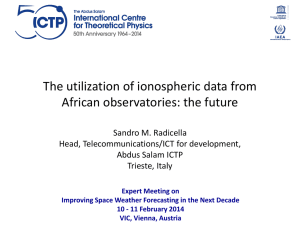Equatorial_iono_requirements
advertisement
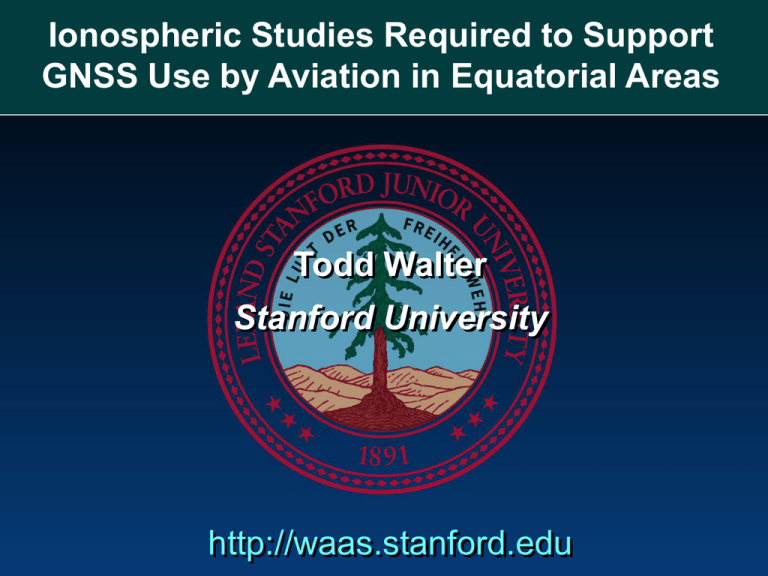
Ionospheric Studies Required to Support
GNSS Use by Aviation in Equatorial Areas
Todd Walter
Stanford University
http://waas.stanford.edu
Purpose
To identify important ionospheric
properties that must be better
understood for GNSS use by
aviation in equatorial areas
2
Ionospheric Issues
Incorrect ionospheric delay values at
the aircraft can create integrity
problems if improperly bounded, or
availability problems when the bounds
become too large
Scintillation may cause the loss of
tracking of one or more satellites
causing a loss continuity
May also cause increased error due to
interrupted carrier smoothing
3
SBAS Ionospheric Working
Group (SIWG)
SIWG has produced two white papers
“Ionospheric Research Areas for SBAS”
February 2003
“Effect of Ionospheric Scintillation on
GNSS”
November 2010
Papers identified equatorial region as
most challenging
Also identified need to collect data
and better characterize effects
4
Critical Properties for Single
Frequency Use
GBAS
Short-baseline gradients
Rate of change, velocity, and width of gradient
Depletions
SBAS
Decorrelation on thin shell
How similar are nearby measurements?
Undersampled errors
How large are features that are undetected?
Temporal Changes
How fast will a vertical delay change?
Nominal vs. Disturbed
5
How does performance vary over time?
Critical Properties for Dual
Frequency Use
Fade depth vs. duration
Time between fades
Regions of sky that can be
simultaneously affected
Correlation between L1 and L5
frequencies
Effect on phase tracking loop
Times, locations, and severity
Effect on SBAS messages
6
GBAS/LAAS Concept
Courtesy: FAA
7
Contributors to Local
Differential Ionosphere Error
Simplified Ionosphere Wave Front
Model:
a ramp defined by constant slope and
width
Error due to code-carrier
divergence experienced by 100second aircraft carrier-smoothing
filter
70
m/s
5 km
Courtesy:
Sam Pullen
GPS
Satellite
Error due to physical
separation of ground and
aircraft ionosphere pierce
points
LGF
Diff. Iono Range Error = gradient slope × min{ (x + 2 t vair),
gradient width}
For 5 km ground-to-air separation at CAT I DH: x = 5 km; t = 100 sec; vair
= 70 m/s
8
=> “virtual baseline” at DH = x + 2 t vair = 5 + 14 = 19 km
20 November 2003
20:30 UT
Courtesy:
Seebany
Datta-Barua
9
Ionosphere Delay Gradients
20 Nov. 2003
35
30
Initial upward
growth; slant
gradients 60
– 120 mm/km
Slant Iono Delay (m)
25
Sharp falling
edge; slant
gradients 250 –
400 mm/km
20
15
Courtesy:
Sam Pullen
“Valleys” with
smaller (but
anomalous)
gradients
10
5
10
0
0
50
100
150
200
250
300
WAAS Time (minutes from 5:00 PM to 11:59 PM UT)
350
WAAS Concept
Courtesy: FAA
Courtesy: FAA
11
•Network of Reference Stations
•Geostationary Satellites
•Master Stations
•Geo Uplink Stations
Thin-Shell Model
12
Correlation Estimation
Process
13
Ionospheric Decorrelation
About a Planar Fit (1st Order)
14
Ionospheric Decorrelation
Function (1st Order)
15
Equatorial Ionosphere
1st Order
16
Equatorial Sigma Estimate
1st Order
17
st
1
Sigma Estimate
Order
(Sliced by Time)
18
Failure of Thin Shell Model
Courtesy:
Seebany
Datta-Barua
Quiet Day
19
Disturbed Day
Undersampled Condition
Courtesy:
Seebany
Datta-Barua
20
WAAS Measurements
Courtesy:
Seebany
Datta-Barua
21
Temporal Gradients
200 s
Slide
Courtesy
Seebany
Datta-Barua
22
Nominal C/N0 without Scintillation
Ionosphere
C/N0
(dB-Hz)
Carrier to Noise density Ratio (C/N0)
Nominal
100 s
23
Ionospheric Scintillation
Electron density irregularities
C/N0
(dB-Hz)
Carrier to Noise density Ratio (C/N0)
Ionospheric
scintillation
25 dB fading
100 s
24
Challenge to Worldwide LPV-200
Challenge to expand LPV-200 service to equatorial area
- Strong ionospheric scintillation is frequently observed
in the equatorial area during solar maxima.
25
Strong Ionospheric Scintillation
7 SVs out of 8
(worst 45 min)
18 March 2001
Ascension Island
Data from
Theodore Beach,
AFRL
C/N0
(dB-Hz)
100 s
26
Benefit from a back-up channel
Lost L2C, but tracked L1
Loss of L2C alone
Loss of L1 & L2C
60 s (zoomed-in plot)
27
Summary
LISN provides an excellent
opportunity to better understand
important extreme characteristics of
the equatorial ionosphere
Delay
Gradients, thin-shell decorrelation, small
scale features, frequency of occurrence
Scintillation
28
Fade depth, duration, time between fades,
spatial correlation, frequency correlation,
phase effects, message loss, and patterns of
occurrence
st
1
Sigma Estimate
Order
(Sliced by Time)
29
Solar Max Quiet Day
July 2nd, 2000
30
CASE I: Moderate scintillation on 5 March 2011 (UT)
Less than 10 dB fluctuations
31
Histogram of C/N0 difference during scintillation
C/N0(L2C) minus C/N0(L1) at the same epoch during scintillation.
Usually 2-3 dB difference between L1 and L2c.
32
Percentage of C/N0 difference during scintillation
Percentage of (C/N0 difference > Threshold of C/N0 difference)
e.g., Only 4.4% of samples have C/N0 difference of
3 dB or more between L1 and L2C at the same epoch
during scintillation.
33
CASE II: Strong scintillation on 15 March 2011 (UT)
More than 15 dB fluctuations
Our way to indicate
no C/N0 output (loss of lock)
34
Percentage of C/N0 difference during scintillation
17.9% of samples have C/N0 difference of 3 dB or more
between L1 and L2C during strong scintillation, which is
better than the moderate scintillation case (4.4%).
Under higher fluctuations, C/N0 difference between two
frequency at the same epoch tends to be also higher.
35
Receiver response during the 800 s of strong scintillation
Although tracking both frequencies can provide benefit under
strong scintillation, the actual receiver response showed that
both frequencies were lost simultaneously in 94.6% cases,
and L2C-only loss was observed in 5.4% cases.
There was no case of L1-only loss during the 800 s strong scintillation.
36
CASE III: Strong scintillation on 16 March 2011 (UT)
More than 15 dB fluctuations
37
Percentage of C/N0 difference during scintillation
18.8% of samples have C/N0 difference of 3 dB or more
between L1 and L2C during this period, which is similar to
the case of 15 March 2011 (17.9%)
38
Previous Studies
- El-Arini et al. (Radio Sci, 2009) observed highly-correlated fadings
between L1 and L2. (L1 and L2 military receiver and 20 Hz outputs)
39
Previous Studies
- Klobuchar (GPS Blue Book) showed signal intensities of L1 and L2
during scintillation.
- Deep fadings are not highly correlated in this example.
40
Ionospheric Decorrelation
(0th Order)
41
Ionospheric Decorrelation
Function (0th Order)
42
Estimation of Ionospheric
Gradients
Station Pair
Method
Mixed Pair
Method
Time Step
Method
T1
T2
IPP
S1
Slide
Courtesy
Jiyun Li
43
S2
• Long baselines
• Free from satellite
IFB calibration error
S1
S2
• Long and short
baselines
• IFB calibration
error on both SV
and RR
S1
• Short baselines
• Free from IFB
calibration error
• Corrupted by iono.
temporal gradients
GBAS: Gradient Threat
Ionosphere
44
SBAS: Undersampled Threat
Ionosphere
Estimated
Ionosphere
45
Obliquity Factor
46
Ionospheric Threat
47
Nominal Day Spatial Gradients
Between WAAS Stations
Typical Solar Max Value:
Below 5 mm/km
Slide
Courtesy
Seebany
Datta-Barua
48
Spatial Gradients Between WAAS
Stations During Anomaly
Slide
Courtesy
Seebany
Datta-Barua
49
Storm Values:
> 40 mm/km
up to 360 mm/km
Disturbed Ionosphere
Decorrelation
50
Simultaneous Loss of
Satellites
Chance of simultaneous loss is strongly
dependent on reacquisition time of receiver
Slide
Courtesy
Jiwon Seo
51
20 sec Loss
18 sec
Max of 4 SV Loss
Simultaneous Loss of
Satellites
Chance of simultaneous loss is strongly
dependent on reacquisition time of receiver
Slide
Courtesy
Jiwon Seo
52
2 sec Loss
18 sec
Max of 2 SV Loss
Number of Tracked Satellites
Simulating 20 sec reacquisition time (WAAS MOPS limit)
Using 45 minutes of severe scintillation data
4 or more: 97.9 %, 5 or more: 92.3 %, 6 or more: 68.1 %
100 %
4 or more
tracked SVs
5 or more
Time
Percentage
Slide
Courtesy
Jiwon Seo
53
6 or more
65 %
2 sec
Reacquisition Time
20 sec
Number of Tracked Satellites
Simulating 2 sec reacquisition time
4 or more: 100 %, 5 or more: 100 %, 6 or more: 98.3 %
WAAS MOPS limit (20 sec) should be reduced
100 %
4 or more
tracked SVs
5 or more
Time
Percentage
Slide
Courtesy
Jiwon Seo
54
6 or more
65 %
2 sec
Reacquisition Time
20 sec
Correlation of Fades between Satellites
* Worst 45 min data from the 9 day campaign at Ascension Island in 2001
300 s
PRN 11
8 SVs
in view
Instance of loss of lock
(each blue dot)
15%
correlation
PRN 4
45 min
55
Availability of LPV-200 (parametric study)
Assuming max temporal range error (0.5 m/s)
- High availability for short reacquisition time (< 2 s)
10
< 50%
Availability of a single user
at Ascension Island
Reacquisition
Time (s)
Availability
Level
> 50%
> 75%
99.5%
> 90%
> 95%
> 99.9%
0
0
L1/L5 Correlation
Coefficient
1
56
